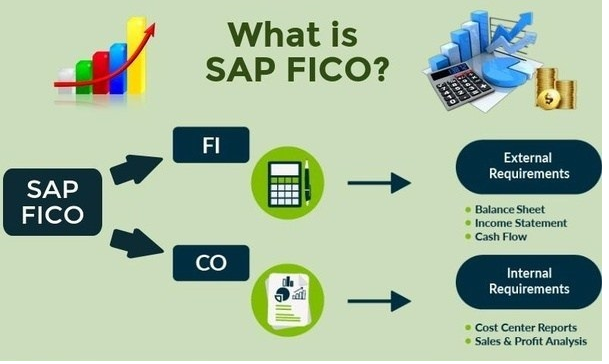The fact that you are reading this SAP FICO Tutorial drives me
to an assumption that you are familiar with the world of SAP and the
technological disruptions that have been rampant in it in the recent years.
One such disruption is SAP FICO. An integration of SAP Finance Accounting
and SAP Controlling modules, SAP FICO often pops up in the mind of finance
specialists when they are supposed to operate around financial transaction
data. While SAP FI (Financial Accounting) records, collects, and
processes financial transactions in real-time for providing necessary inputs
for external reporting, SAP CO (Controlling) is leveraged for internal
reporting and improved decision making. The SAP FICO consultant job is a
symbolizes as one of the most lucrative career paths in the market today,
interested in learning SAP FICO? Click here to learn more in this SAP FICO Training!
Components of the Financial (FI)
Module
General Ledger Accounting
Accounts Payable
Accounts Receivable
Treasury
Asset Accounting
Consolidations
Organizational Units in FI
The Client
The client is the highest hierarchical level
in the SAP System. Specifications that you make or data that you enter at this
level are valid for all company codes and for all other organizational
structures. Each client is a self-contained unit with separate master records
and a complete set of tables.
The Company
A company is the smallest organizational unit for
which legal individual financial statements such as balance sheets and profit
and loss statements can be created according to the respective commercial
legislation. A company can include one or more company codes. The financial
statements of a company are also the basis of a consolidated financial
statement.
The Company Code
A company code is the smallest organizational
unit for which complete, independent accounting can be carried out. A legally
independent company is generally represented by one company code in the SAP
System. In accounting, you enter, save and process business transactions, and
manage accounts fundamentally at company code level. A further subdivision is
possible via internal organizational Units (Ex: Business Areas)
The Chart of Accounts
The chart of accounts is the second highest
hierarchical level in the SAP System. It is assigned to the company code. It is
a list of all natural accounts available to all company codes.
Terminology in FICO
Company Code
Smallest organizational unit of
external accounting for which a complete, self-contained set of accounts (COA)
can be created. Similar to what is now considered a legal entity.
Document
Representation of an accounting
document or entry in the SAP system
Chart of Accounts
A framework of GL accounts for the
recording of values to ensure an orderly rendering of accounting data. The
operational chart of accounts is used by financial accounting and cost
accounting. The items in a chart of accounts can be expense or revenue accounts
in FI and cost or revenue elements in cost accounting. Each company code is
assigned to a chart of accounts.
Profit Center
An organizational unit in
Accounting used for controlling purposes. Similar to what is now considered an
origin.
Cost Center
An organizational unit that
represents a defined location of cost incurrence. Similar to what is now
considered a department.
Customer Master
Customer data that includes
addresses, account balances, and credit limits that are maintained centrally to
prevent duplication.
Vendor Master
Vendor data that includes addresses,
payment details, and account balances of all vendors with which AOI conducts
business. Vendor master records are centrally maintained to prevent
duplication.
Posting Key
A two-digit numerical key that
determines the way line items are posted. This key determines several factors
including the account type, type of posting (debit or credit) and layout of
entry screens.
Account Group
Used to categorize accounts that have
similar master data requirements. It determines the required master data needed
for creating G/L accounts. It also determines the number range in which the
customer account should be placed, and whether that number is to be assigned by
the user or by the system.
Ledger
In G/L Accounting, you can use several
ledgers in parallel. This allows you to produce financial statements according
to different accounting principles, for example.
Fiscal Year Variant
A period as defined by the
financial calendar. The fiscal year variant contains the number of posting
periods in the fiscal year and the number of special periods. You can define a
maximum of 16 posting periods for each fiscal year in the Controlling component
(CO).
Posting Period
Variant
You can specify which company
codes are open for posting in a posting period variant. Posting period variants
are cross-company code and you have to assign them to your company codes. The
posting periods are then opened and closed simultaneously for all company codes
via the posting period variants.
Reconciliation
Account Summary account for sub
ledgers such as Accounts Receivable, Accounts Payable, and Asset Accounting. No
direct postings to reconciliation accounts are allowed.
Cost Element
A cost element classifies the
organization's valuated consumption of production factors within a controlling
area. A cost element corresponds to a cost-relevant item in the chart of
accounts.
Primary Cost
Element
A cost element whose costs originate
outside of CO and accrual costs that are used only for controlling purposes.
Open Item
Management
A stipulation that the items in an account must be
used to clear other line items in the same account. Items must balance out to
zero before they can be cleared. The account balance is therefore always equal
to the sum of the open items.










No comments:
Post a Comment